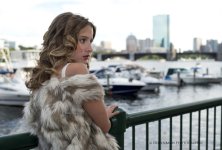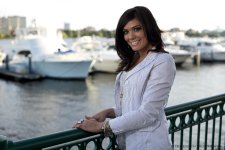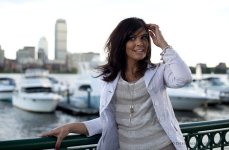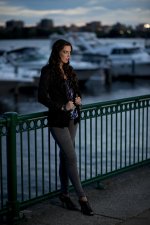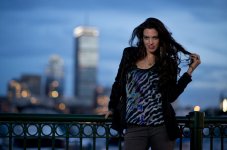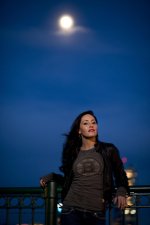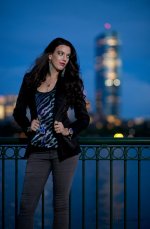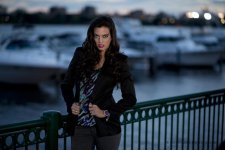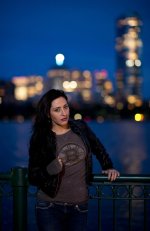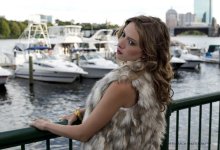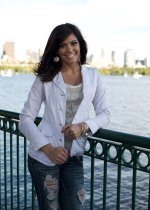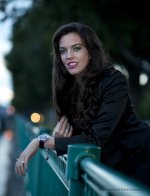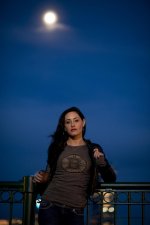You are using an out of date browser. It may not display this or other websites correctly.
You should upgrade or use an alternative browser.
You should upgrade or use an alternative browser.
Evening Model Photo Shoot Charles River
- Thread starter crycocyon
- Start date
So the off-camera setup was the SB-800 mounted on a Yongnuo YN622N i-TTL wireless flash trigger/receiver, which itself was mounted on a Calumet light stand using a swivel/tilt flash holder. Mounted to the SB-800 was a 10x14" LumiQuest SoftBox LTp. Supplementary power for the SB-800 was provided by an SD-8A battery pack.
For the earlier evening shots with more available light, I placed the flash at around 6.5 to 7' height and around 2-4 feet immediately to my right. For the later evening shots with low light, the flash was placed at 7' perpendicular to the railing around 20' away. In both instances, once I knew the appropriate exposure, then I could move around AND THE EXPOSURE WON'T CHANGE because the distance of the light to the subject doesn't change. So I can move around the model a bit, look for the right kind of light angle because of course the direction of light is the same and the model either turns into or turns away from the light, and I can see that effect as I shoot so I'm modelling the light. You can tell where I am and where the light is in relationship to the railing. The models are all in about the same position (apart from the first one) and I just move the light to where I want it. One fun thing about the setup is to get more light I can also just move the stand closer to the model, or to get more of a fill effect than a key light effect, I move it back, while keeping output the same. TTL will then work just to balance the light.
I was shooting in high-speed sync mode on the D800. This means when I shoot in manual, I can adjust the shutter speed for a given aperture (which I tried to keep reasonably wide for softer bokeh) in order to get the correct exposure. The flash is set up for TTL and the secret is to override the flash output because invariably it looks like flash then. I tried to reduce output until I got what looked like an ambient light effect with the flash, which you see more in the earlier evening photos. The light hitting their faces is flash because the sun is actually behind them setting toward the right (down the river). I set the flash to around -2 and 2/3 less. I also underexpose the exposure on the camera, usually -0.7 to -1.0. I have many examples where the flash was a bit too noticeable and powerful. The fun part of this setup is all I have to do to darken the background and intentionally bring out the flash is use faster shutter speeds (shorten exposure time). Earlier in the evening I was shooting 200 ISO, then when the sun went down it was 400 ISO.
To get the moon in the frame, I had to go on the ground shooting up to the model, and I'm 20' back with the light stand about 2 ft to my left. When the model looks up, she looks up towards the light, making it seem almost like moonlight or other ambient light. But it is flash that illuminates the models entirely in the later evening shots. As it got dark, I had to open up the aperture a bit. During the course of the evening, I started out shooting around 1/250th a second, then when I needed to get more of the light from the city in the background, I went down to 1/40th of a second, shooting with the 85 mm (!!). So that's handheld and the challenge was that if the model moves, there's so little light from the flash that the movement can be seen as well, like a double image. So there are many shots that didn't turn out because of that model movement.
Whew! I think that covers most of it....
For the earlier evening shots with more available light, I placed the flash at around 6.5 to 7' height and around 2-4 feet immediately to my right. For the later evening shots with low light, the flash was placed at 7' perpendicular to the railing around 20' away. In both instances, once I knew the appropriate exposure, then I could move around AND THE EXPOSURE WON'T CHANGE because the distance of the light to the subject doesn't change. So I can move around the model a bit, look for the right kind of light angle because of course the direction of light is the same and the model either turns into or turns away from the light, and I can see that effect as I shoot so I'm modelling the light. You can tell where I am and where the light is in relationship to the railing. The models are all in about the same position (apart from the first one) and I just move the light to where I want it. One fun thing about the setup is to get more light I can also just move the stand closer to the model, or to get more of a fill effect than a key light effect, I move it back, while keeping output the same. TTL will then work just to balance the light.
I was shooting in high-speed sync mode on the D800. This means when I shoot in manual, I can adjust the shutter speed for a given aperture (which I tried to keep reasonably wide for softer bokeh) in order to get the correct exposure. The flash is set up for TTL and the secret is to override the flash output because invariably it looks like flash then. I tried to reduce output until I got what looked like an ambient light effect with the flash, which you see more in the earlier evening photos. The light hitting their faces is flash because the sun is actually behind them setting toward the right (down the river). I set the flash to around -2 and 2/3 less. I also underexpose the exposure on the camera, usually -0.7 to -1.0. I have many examples where the flash was a bit too noticeable and powerful. The fun part of this setup is all I have to do to darken the background and intentionally bring out the flash is use faster shutter speeds (shorten exposure time). Earlier in the evening I was shooting 200 ISO, then when the sun went down it was 400 ISO.
To get the moon in the frame, I had to go on the ground shooting up to the model, and I'm 20' back with the light stand about 2 ft to my left. When the model looks up, she looks up towards the light, making it seem almost like moonlight or other ambient light. But it is flash that illuminates the models entirely in the later evening shots. As it got dark, I had to open up the aperture a bit. During the course of the evening, I started out shooting around 1/250th a second, then when I needed to get more of the light from the city in the background, I went down to 1/40th of a second, shooting with the 85 mm (!!). So that's handheld and the challenge was that if the model moves, there's so little light from the flash that the movement can be seen as well, like a double image. So there are many shots that didn't turn out because of that model movement.
Whew! I think that covers most of it....
You sound like you really know what you're doing with off-camera flash. My experience with off-camera flash is limited, I know roughly what I am doing but I'm not comfortable and haven't had much experience using it. I have the equipment to use off-camera flash in TTL (My D7100 has a wireless feature) but I always thought it was best to use flash in manual.
I realise that when the aperture is changing, so will the flash power so perhaps TTL would be best. I only have an umbrella here, I've never used a softbox. I'd assume bouncing off a reflector would be effective? By the way, very nice shots.
I realise that when the aperture is changing, so will the flash power so perhaps TTL would be best. I only have an umbrella here, I've never used a softbox. I'd assume bouncing off a reflector would be effective? By the way, very nice shots.
Last edited:
Actually you and I probably have similar experience because I only got this equipment in the past couple of months.  Although I have done photography on and off for a LONG time (ie: since I was a kid in the 70s). And I did a LOT of research into off-camera flash and studio lighting because it is the one thing I didn't really have a good handle on. Well since the SB series works in TTL you can use it so that the camera determines the light output but you have the camera in manual in order to force the flash to compensate and in that way you find the balance of artificial and ambient light. An umbrella would work the same way, except you'll need to move it closer to the subject on account of fall-off. Does your umbrella have a silvered interior? You could then use it as a reflector for the flash instead of flashing through the umbrella as a diffusor.
Although I have done photography on and off for a LONG time (ie: since I was a kid in the 70s). And I did a LOT of research into off-camera flash and studio lighting because it is the one thing I didn't really have a good handle on. Well since the SB series works in TTL you can use it so that the camera determines the light output but you have the camera in manual in order to force the flash to compensate and in that way you find the balance of artificial and ambient light. An umbrella would work the same way, except you'll need to move it closer to the subject on account of fall-off. Does your umbrella have a silvered interior? You could then use it as a reflector for the flash instead of flashing through the umbrella as a diffusor.
And thanks!
And thanks!
crycocyon, Less than 2 years ago, my only photography experience was with a budget phone camera and i've self taught myself since then. I've done 5 weddings now, several christenings and a few other things but all have been with on-camera flash. My results have been good but could be so much nicer with off-camera flash. My umbrella has a black cover which can be removed (however, I think it's broken because when I clip the cover around the umbrella, when I close and reopen, the cover falls off!) The inner is a white satin material, not silver. I do have a 5 in 1 reflector though which has a silver side. Would doing this sort of stuff via a shoot-through umbrella work well?
A few question if you don't mind helping me out:
1) At the start, with the flash turned off, do you measure the ambient exposure with the model in the frame or do you just meter off the background?
2) With TTL off-camera I think you say you use FEC (Flash Exposure Compensation) to control the flash power? How do you do this? From the flash unit? or on camera itself? Does your EC (Exposure Compensation) effect both the camera and flash exposure or have you got it set to just affect the camera exposure? On my D7100, I can set the EC setting to either effect just the camera exposure or both the camera exposure and flash.
A few question if you don't mind helping me out:
1) At the start, with the flash turned off, do you measure the ambient exposure with the model in the frame or do you just meter off the background?
2) With TTL off-camera I think you say you use FEC (Flash Exposure Compensation) to control the flash power? How do you do this? From the flash unit? or on camera itself? Does your EC (Exposure Compensation) effect both the camera and flash exposure or have you got it set to just affect the camera exposure? On my D7100, I can set the EC setting to either effect just the camera exposure or both the camera exposure and flash.
So you could still use that umbrella with white satin material inside as a soft reflector.
1. I meter with the model in the frame. I want to meter for the model first, then check the background and if it is dark, I bring up the exposure (reduce shutter speed), if the model is too bright and the background is fine, then I increase flash output or bring it closer to the model (usually the latter).
2. Yes that's right, FEC. I make exposure compensations on the flash because it's quicker. In e5 of the Bracketing/flash menu on my D800 (which is the same I think on the D7100) I have it set to "AE & flash" so it is affecting both the camera and the flash. But again, I'm not making compensation on the flash unless I am forced to bring down the power a lot to balance the light better. I can make adjustments to the distance of the flash to the subject to more quickly adjust the amount of light hitting the subject.
So I'm using TTL BL FP mode on the SB-800, so "through the lens metering", "balanced fill-flash", and "auto FP high speed sync". My camera is set to 1/250s (Auto FP) for flash sync speed.
Hope that helps....
1. I meter with the model in the frame. I want to meter for the model first, then check the background and if it is dark, I bring up the exposure (reduce shutter speed), if the model is too bright and the background is fine, then I increase flash output or bring it closer to the model (usually the latter).
2. Yes that's right, FEC. I make exposure compensations on the flash because it's quicker. In e5 of the Bracketing/flash menu on my D800 (which is the same I think on the D7100) I have it set to "AE & flash" so it is affecting both the camera and the flash. But again, I'm not making compensation on the flash unless I am forced to bring down the power a lot to balance the light better. I can make adjustments to the distance of the flash to the subject to more quickly adjust the amount of light hitting the subject.
So I'm using TTL BL FP mode on the SB-800, so "through the lens metering", "balanced fill-flash", and "auto FP high speed sync". My camera is set to 1/250s (Auto FP) for flash sync speed.
Hope that helps....
Thanks for your reply
The white material is a far bit transparent, why would you suggest I use the umbrella as a bounce rather than shoot-through?
I am confused by what you said. I understand the first part but the second you said if the model is too bright, you'd increase flash output or bring the flash close to the model. Wouldn't this make the model even more bright?
I have mine set to Auto FP 1/320sec why is yours at 1/250s?
So you could still use that umbrella with white satin material inside as a soft reflector.
The white material is a far bit transparent, why would you suggest I use the umbrella as a bounce rather than shoot-through?
1. I meter with the model in the frame. I want to meter for the model first, then check the background and if it is dark, I bring up the exposure (reduce shutter speed), if the model is too bright and the background is fine, then I increase flash output or bring it closer to the model (usually the latter).
I am confused by what you said. I understand the first part but the second you said if the model is too bright, you'd increase flash output or bring the flash close to the model. Wouldn't this make the model even more bright?
So I'm using TTL BL FP mode on the SB-800, so "through the lens metering", "balanced fill-flash", and "auto FP high speed sync". My camera is set to 1/250s (Auto FP) for flash sync speed.
I have mine set to Auto FP 1/320sec why is yours at 1/250s?
I don't know if it's my monitor but they all seem a little to dark. They need more flash.
I think I have to agree, they do seem a little dark.
Thanks for your reply
The white material is a far bit transparent, why would you suggest I use the umbrella as a bounce rather than shoot-through?
That will be up to you. Bounce inside will give you more light while shooting through it will give you softer shadows.
I am confused by what you said. I understand the first part but the second you said if the model is too bright, you'd increase flash output or bring the flash close to the model. Wouldn't this make the model even more bright?
I think I meant too dark for the model as well....
I have mine set to Auto FP 1/320sec why is yours at 1/250s?
Because I still wanted from 1/320 to 1/250 to be Auto FP rather than flash sync to give me more flexibility.
Because I still wanted from 1/320 to 1/250 to be Auto FP rather than flash sync to give me more flexibility.
I'm not understanding so I will have a read up about Auto FP and flash sync
I still find your images a tad too dark and my monitor is calibrated with an i1 Pro Display. I guess it's down to personal preference.

